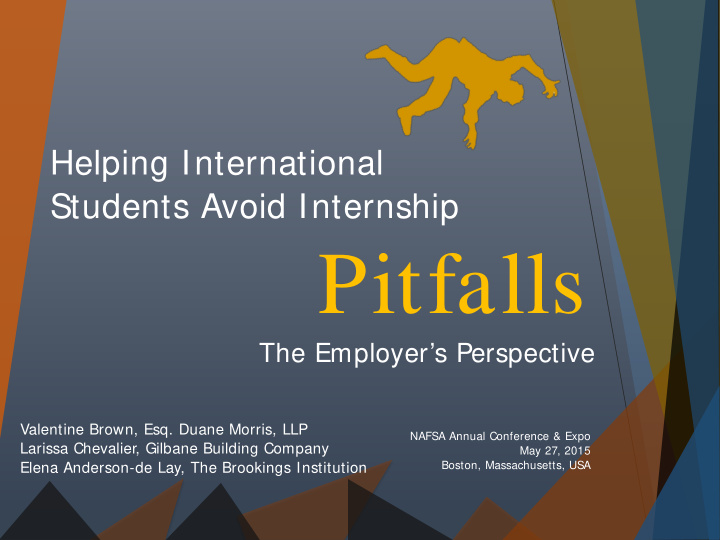



Helping International Students Avoid Internship Pitfalls The Employer’s Perspective Valentine Brown, Esq. Duane Morris, LLP NAFSA Annual Conference & Expo Larissa Chevalier, Gilbane Building Company May 27, 2015 Boston, Massachusetts, USA Elena Anderson-de Lay, The Brookings Institution
Scope of the session 4. Propose opportunities 3. Address challenges 2. S how different models 1. Define internships
So what’s an internship? Talent Cultivation
Internships at Brookings Competitive selection Both paid and unpaid (for credit) Talent pipeline for professional positions
Internships at Gilbane Sourced through University partnerships All paid internships/co-ops Training program for future full-time opportunities
Duane Morris, LLP Role of counsel Clients’ use of internships vary Engineering, pharmaceutical, and IT industries
Employers Hosting Interns
Internship Considerations Paid or Unpaid Increased scrutiny by Department of Labor Increased willingness to litigate by students and graduates Legal standards are evolving Employers and Universities unclear as to best practices
Unpaid Internships and the Fair Labor Standards Act (FLSA)
DOL’s 6-Part Test - FLSA Educational No Intern employer Benefit benefit UNPAID INTERNSHIPS No No job employee entitlement displacement No wage entitlement
Winning Arguments (Unpaid Internships) Employer benefited from the work I performed Employer would have had to hire additional staff if I had not performed work Employer did not provide me with academic or vocational training Employer uses unpaid interns to minimize labor costs
Effects of Increased DOL Scrutiny Legal confusion - courts applying different standards in pending cases Fewer internships available Colleges/universities taking additional steps to confirm internships’ compliance with the FLSA
Reducing Risk Internship Agreement Interns should not perform work that would otherwise be performed by paid employees Interns should not be used for “budgetary reasons” Interns should receive academic credit
International Students as Interns Specific Challenges
Employer Challenges Identifying qualified International Students I-9 Documentation OPT STEM Challenges
Employer Challenges Faculty member also has a position with an employer International Student works on project with Faculty member Faculty member does not communicate with ISSS office
So what’s in common?
Competing interests University Employer S tudent
Advice? S tudent Faculty Employer DS O/ RO Manager
Opportunities: Partnerships Meet face-to-face with employers Speak with your in-house HR professionals Educate HR professionals about work authorization needs Address internships along with employment discussion with students Connect with the Career Services department
Opportunities: Communication Create some FAQ handouts or a webpage for employers Explain CPT/OPT to employers Remind faculty and department chairs about processes Advise students on documents needed for the I-9 – employers cannot provide these details Check-in with students during internship
Benefits: Adds value to the students’ education Helps employers fill talent gaps Creates efficiencies with onboarding Employers will call again to hire your students
Tools and Guides DOL’s Wage and Hour Fact Sheet # 71 DOL Opinion letter FLSA2004-5NA NAFSA Adviser’s Manual International Student Advising (ISTA) and International Scholar Advising (ISCA) networks
Questions?
Thanks for Joining Us! Larissa Chevalier lchevalier@gilbaneco.com Elena Anderson-de Lay ejanderson@brookings.edu Valentine Brown, Esq. vbrown@duanemorris.com Questions?
Recommend
More recommend